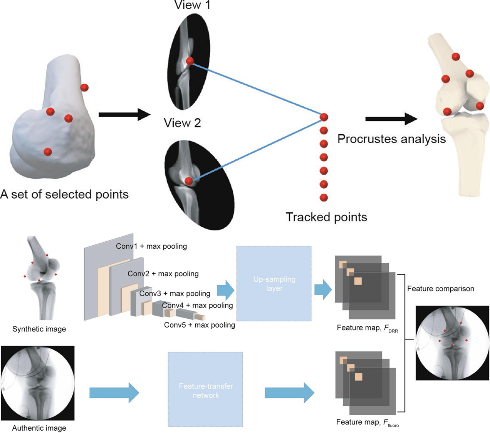


Bionic 3D printing and personalised implants
Bionic 3D printing is used to produce biomimetic cartilage tissue and micro-scale vascular network to treat cartilage defects and local vascular damage, analyze the mechanism of autologous fibroblasts to maintain the stability of degenerative intervertebral discs, and manage degenerative disc diseases. Combined with methods using hot solvents, special bio-modification inks are used to develop bio-3D printed tissue engineering scaffolds to treat osteosarcoma and diabetic bone defects. For pre-operative guidance, machine learning has been used to assist biplane X-ray assessment of bone and joint function to optimize personalized implant design and support the application of 3D printing for personalized implants.

Knee kinematics measurement with feature transfer learning
Selected Publications:
1. Wang C, Xie S, Li K, et al. Multi-view point-based registration for native knee kinematics measurement with feature transfer learning. Engineering, 2021, 7(6): 881-888.
2. Sun X, Ma Z, Zhao X, et al. Three-dimensional bioprinting of multicell-laden scaffolds containing bone morphogenic protein-4 for promoting M2 macrophage polarization and accelerating bone defect repair in diabetes mellitus. Bioactive Materials, 2021, 6(3): 757-769.
3. Li S, Wang W, Li W, et al. Fabrication of thermoresponsive hydrogel scaffolds with engineered microscale vasculatures. Advanced Functional Materials, 2021, 31.
4. Kernkamp W, Wang C, Li C, et al. The medial patellofemoral ligament is a dynamic and anisometric structure: an in vivo study on length changes and isometry. The American Journal of Sports Medicine, 2019, 47(7):1645-1653.
5. Wang C, Kernkamp W, Li C, et al. Elongation and orientation pattern of the medial patellofemoral ligament during lunging. Journal of Orthopaedic Research, 2021, 39(9): 2036-2047.